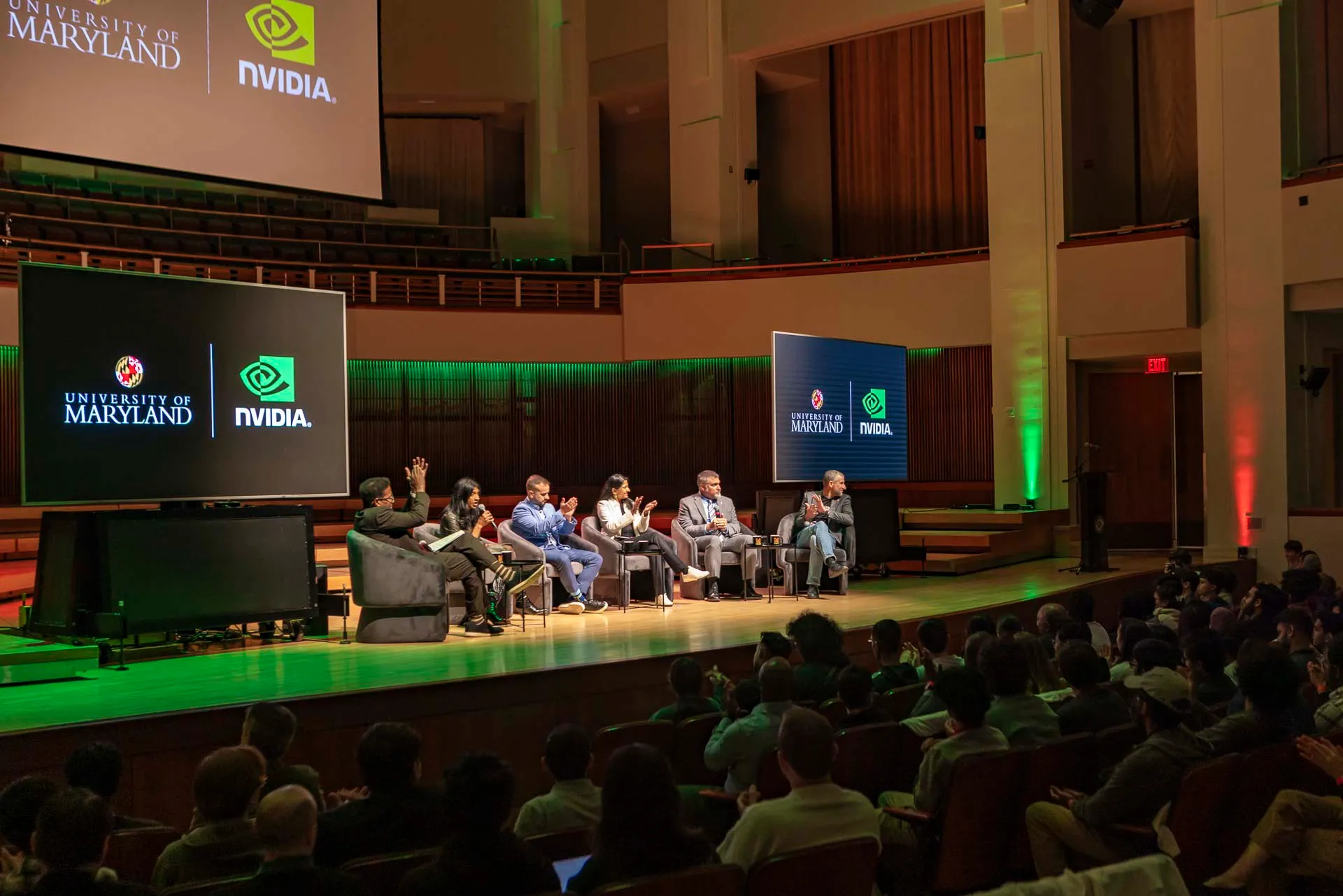- October 29, 2025
- By Chris Carroll
Hundreds of University of Maryland students soaked up career advice on Tuesday from officials at the world’s highest-valued company and heard what’s next on the tech agenda from its rock star CEO.
In fact, Nvidia leader Jensen Huang was physically located a few miles south in the nation’s capital as he delivered the keynote address at the company’s annual artificial intelligence-focused GTC Conference, appearing via video feed in The Clarice Smith Performing Arts Center’s Dekelboum Concert Hall. Other company executives visited College Park, where they participated in discussion panels and distributed pricey Nvidia swag including—for the two luckiest attendees—RTX 5090s, the most powerful consumer graphics processing units (GPU) ever sold, with retail prices starting at $2,000.
“No. 1, I’m here for the raffle—although I know I’m not going to win,” said Adil Kasim ’26, a computer science major who wants to find a job in AI-centric tech development. “A close No. 2 is hearing about what they’re doing new. Are they introducing a new generation of GPU, or doing something different with current technology?” (The top news from the speech was Nvidia’s plan to develop 6G mobile telecom technology with cell phone pioneer Nokia, along with its $1 billion investment in the Finnish company.)
Nvidia GPUs are a staple in video gaming—close to the hearts of many attendees—but more importantly, the company’s hardware has been central to the recent ascendency of generative AI utilities including chatbots such as ChatGPT and image generation models like Midjourney.
As a leader in AI research and education, the University of Maryland hosting an Nvidia-sponsored event was a natural fit, attendees said.
“AI is such a buzzword now, and everyone’s talking about it, but Nvidia is special in the field of AI,” said Divisha Gupta M.S. ’24, who said the Santa Clara, Calif.-based firm is her dream employer. “I’m here because it’s always best to learn from the best.”

From left, UMD President Darryll J. Pines; Maryland Lt. Gov. Aruna Miller; Konstantin Cvetanov, Nvidia senior solutions architect; Neelima Rao, AstraZeneca vice president of human resources for global oncology R&D and North America country lead; Mike Boteler, Whiting-Turner Contracting Co. vice president; Jesse Kellner, Cloudforce chief operating officer.
The day’s events began with a panel led by UMD President Darryll J. Pines and including Maryland Lt. Gov. Aruna Miller and AI industry leaders from Nvidia, AstraZeneca, the Whiting-Turner Contracting Co. and Cloudforce.
Pines pointed out the role of UMD computer scientists in building the foundation of language models—the technology underlying today’s advanced chatbots—with the BERT and ELMO models, named as a homage to alumnus Jim Henson ’60.
The university continues its AI leadership in order to create positive impacts for the people of Maryland and the world, Pines said.
“We have been working diligently to produce the research, develop the programs and influence the policies we need to make sure AI tools are used in an ethical, trustworthy and responsible way for the benefit of everyone,” he said.
The talk was introduced by Maryland Secretary of Higher Education Sanjay Rai, who declared, “Maryland is not just watching the AI revolution, we are building it. We are training our students to lead it.”
The panel discussion began with an overview of advances in AI and predictions about its future. Nvidia Senior Solutions Architect Konstantin Cvetanov said members of Nvidia’s increasingly AI-assisted workforce use “agents”—AI systems that work to achieve goals without constant oversight from human users.
Although Cvetanov said he sees a future in which AI accomplishes most of the labor in many fields, “if you’re a physicist or a chemist or a lawyer, the AI agent is not going to replace you,” he says. “You have to be there to be the steward.”
The panel concluded with advice for students in attendance—much of it to not over-rely on AI. Jesse Kellner MBA '16, COO of Cloudforce, the company that developed TerpAI, counseled attendees to work on soft skills and emotional IQ.
“Don’t let AI be a shortcut or a cheat code to not putting in the work,” said Kellner, also an adjunct lecturer in the Robert H. Smith School of Business. “Focus on integrity. In the same way Maryland is building Do Good Terps, be a great person.”
Afterward, another student in attendance said he appreciated that advice, as well as urging by Whiting-Turner Vice President Mike Boteler ’05 to avoid allowing AI to take over your voice and identity when applying for jobs.
“The biggest and most important takeaway was to use AI to augment yourself rather than mask who you truly are,” said Thomas Zhong ’27, a computer science major who helped start a student organization for those interested in AI safety—including ensuring AI systems reflect human values and can be adequately controlled as they become more powerful. “Stay true to your character and focus on what you’re really interested in, since AI can help you get there.”
AI at Maryland
The University of Maryland is shaping the future of artificial intelligence by forging solutions to the world’s most pressing issues through collaborative research, training the leaders of an AI-infused workforce and applying AI to strengthen our economy and communities.
Read more about how UMD embraces AI’s potential for the public good—without losing sight of the human values that power it.
Topics
Campus & CommunityUnits
Office of the President